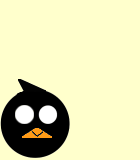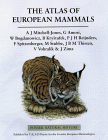
PICK OF THE GERMAN WEEK 2000
The Red Kite Milvus milvus 
German Bird of the Year 2000

PICK OF THE GERMAN WEEK 2000
The Red Kite Milvus milvus 
German Bird of the Year 2000
PICK OF THE GERMAN WEEK 04/2000
ENVIRONMENT
WINTER NEWS FROM THE GERMAN BIRDNET
POMS, WAXWINGS AND LOONS
The end of winter is surely in sight with the first blackbirds tuning up in the towns and cities (and see other signs of spring below. Time for a short, but guaranteed not complete retrospect of the first winter months, November to mid-January. This review is a summary, with comments, of the many sightings reported by GermanBirdNet subscribers. An evaluation or analysis of the sightings is not attempted.
The two irruptions forecast in October swung into action during November. First, the numbers of Waxwings (Bombycilla garrulus) in Northern Germany increased noticeably - and were restricted to the geographical north along the Baltic and North Sea Coasts and their immediate hinterland. The vast majority of the sightings were from the provinces of Schleswig-Holstein and Mecklenburg, together with the city-states of Hamburg and Bremen. Lower Saxony had much fewer sightings, while Hessen and North Rhine-Westphalia had almost none to report. Perhaps more spectacular was the irruption of young Pomarine Skuas (Stercorarius pomarinus) which, with 'hangers-on' and 'late starters' went on well into December. Whilst spectacular fly-pasts took place off Dunkirk, the sightings in Germany were almost all restricted to migrating individuals, some of which attached themselves to Africa-bound Common Crane (Grus grus) flocks. The irruption of the 'Poms' reached the foothills of the Alps. An oversight of the extent and size of these irruptions is still being compiled. Nevertheless the effectiveness of the telephone (static and mobile), and above all the E-mail and Internet systems as information carriers, was once again proved invaluable and did much to ,motivate birders in getting out into the field and expand the information data base. Gone are the days (happily) when news of such interest was available to the average birder t3 months later in his bird magazine.
A limited irruption of Red-breasted Mergansers (Mergus serrator) was reported from the Leipzig/Altenburg area where 300 birds flew in to 10 lakes. Local ornithologists say that such numbers were not reached previously in a 30-year period. Elsewhere however only small flocks and individuals were reported.
Other specials were a disorientated Long-billed Dowitcher (Limnodromus scolopaceus)on Fehmarn, which stayed for several days and a Gyr Falcon (Falco rusticolus) on the island of Hiddensee on 4 November.
Not to be outdone Bavaria had a first Winter Sabine's Gull (Larus sabini) on 17 November on the Starnberger See (still to be confirmed), a Snowy Owl (Nyctea scandiaca) visited Rostock harbour and a Grey Phalarope (Phalaropus fulicarius) was observed in the Ditmarscher Koog nature reserve on edge of the Wadden Sea.
The usual Glaucous Gulls (Larus hyperboreus), regular visitors for the last few years, made inland visits to the Hannover rubbish tip, Datteln and the Muenster Rieselfelder. Sightings went on into January.
The numbers of Great Northern Loons (Gavia immer) equalled if not outdid the impressive figures from last winter and beg the question as to whether the birds are present, but not yet observed, on all suitable inland waters in Germany. Imposing numbers of 'normal' divers were also reported. On the so-called 'Diver Stretch' of the Bodensee/Lake Constance 22 Black-throated Loons (Gavia arctica) were seen as early as the 9 November; on the Starnberger see south of Munich 3 Great Northerns, 30 Black-throated and 2 Red-throated Loons (Gavia stellata) were seen in a single session.
The Waxwing numbers continued to be high throughout December, although most birdwatchers were distracted by the tragic consequences of Erika catastrophe and the severe storms which followed. Oiled Kittiwakes (Rissa tridactyla) were picked up or observed as far away as Switzerland. The storms brought unprecedented numbers of clean but sometimes exhausted seabirds well inland. A rather tired European Storm Petrel (Hydrobates pelagicus) was found as far east as the Allgaeu County in the German Alps. Swiss ornithologists estimate a total of some 40 Storm Petrels, not all of which survived their odyssey. perhaps the storms were also responsible for the 3, obviously wild Barnacle Geese (Branta leucopsis) on Lake Constance on New Year's Eve?
Apart from the 'usual' winter sightings of Snow Goose (Anser caerulescens), Ross's Goose (Anser rossii), Lesser White-fronted Goose (Anser erythropus) and Red-breasted Goose (Branta ruficollis), there were no great excitements. On 3. December an Iceland Gull (Larus glaucoides) was reported from Cuxhaven and an Azure-winged Magpie (Cyanopica cyanus) of the asian race in Bavaria. The latter led to an intensive discussion on the characteristics of the two subspecies and the origin of the Iberian population. Finally, the Spotted Eagle (Aquila clanga) is back. Whereas the bird on the French border in Lorraine failed to appear for the first time in 10 years, an adult bird delighted the birders at the Niederriedstausee near Berne.
Also from Switzerland came the reports in January of two to five, and finally ten million Bramblings (Fringilla montifringilla) in a roost near Fribourg/Vaduz. Another Iceland Gull (Larus glaucoides) was present for two days in the Beltringharder Koog and a Snowy Owl (Nyctea scandiaca) in Rostock could subsequently be interpreted as the spearhead of the invasion in Scandinavia (Finland about 100; South Sweden 35; Denmark 2). Not to mention the Schleswig-Holstein birds on Sylt (17 December and see under) and Westhever sandbank (30 December).
(Material courtesy of the German birdwatching magazine 'Der Falke'/Thomas Griesohn-Pflieger)
BIRD(S)OF THE WEEK
Discussion over the Lesser Scaup (Aythya affinis) ---- Eagle Owl (Bubo bubo) takes up residence high up in Schwerin Cathedral --- --- Saker (Falco cherrug) in Bavaria? --- The Snowy Owl (Nyctea scandiaca) seen again on the island of Sylt ? --- Chiffchaff (Phylloscopus collybita) on the Bodensee/Lake Constance und Mistle Thrush (Turdus viscivorus) in Westphalia are singing.
David Conlin
GermanBirdNet Berlin
mailto:david.conlin@snafu.de
Mobile: +49 172 394 6671
Ô-Ô https://marathonandmore.tripod.com/Das_Beste_Berichte.html Best of Europe
and https://marathonandmore.tripod.com/potgw-home.html POTGW Archives (under
construction)
News from the GermanBirdNet
http://www.birdnet.de
and other sources...



 FOCALPOINT A family specialist business for scopes, bins and birding items - bestellen Sie auch direkt aus Deutschland! Gängige Kreditkarten telefonisch akzeptiert!
FOCALPOINT A family specialist business for scopes, bins and birding items - bestellen Sie auch direkt aus Deutschland! Gängige Kreditkarten telefonisch akzeptiert!
 Royal Society for the Protection of Birds
Royal Society for the Protection of Birds
 Excellent British & European Birder Site (and worldwide): Where to...; Links; Trip Reports; Chat; and ...
Excellent British & European Birder Site (and worldwide): Where to...; Links; Trip Reports; Chat; and ...
 The senior German nature protection society
The senior German nature protection society
 Good site for rare bird news (daily), books, videos & CD
Good site for rare bird news (daily), books, videos & CD

Put your Link Here _______________
 ..... und AMAZON.DE
..... und AMAZON.DE


Bestell Svensson's Der neue Kosmos Vogelführer Heute!